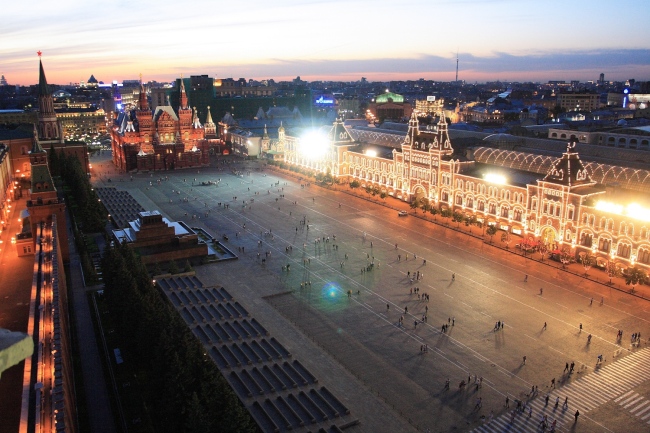 |
This 2007 handout picture shows the GUM shopping mall at Red Square in Moscow. (AFP-Yonhap News) |
MOSCOW (AFP) ― In Soviet days, people queued here to buy Romanian boots or East German bras, but Moscow‘s vast GUM shopping arcade, which turns 120 this year, is now a luxury emporium that plays on Soviet nostalgia.
The official 120th birthday celebrations will take place in several months at the Gosudarstvenny Universalny Magazin (GUM), or State Universal Store, whose three cream-walled arcades topped with a 16,000-square meter glass roof opened opposite the Kremlin in the Tsarist era on Dec. 2, 1893.
But the celebrations began in early July with a Christian Dior catwalk show in a Futurist-style pavilion erected for the occasion on Red Square, next to the Lenin Mausoleum.
The Paris fashion house has historic connections with GUM. As an advertising stunt, it photographed its models here back in 1959 wearing long designer dresses and hats, as curious shoppers gazed on.
Over time, the austere facades of the state-owned stores have been replaced by the logos of Burberry, Calvin Klein and Gucci and the red-brick Kremlin walls are reflected in the windows of a Louis Vuitton boutique.
“Our main partners are luxury brands,” said Timur Guguberidze, the store’s managing director. “But GUM was reconstructed in the Soviet era and we are trying not to forget this period.”
Symbolic of this desire was the 2008 reopening of the fine foods store Grocery No. 1. The 24-hour food store sells Italian cold meat, French champagne and cheese as well as vodka and caviar.
But it is also possible to buy goods popular in the Soviet era: pear-flavored lemonade sold by the glass, birch juice in three-liter jars and ice cream in wafer cups.
“The current management has decided to revive the traditions of the flagship stores of the 1950s and plays on nostalgia for the Soviet period,” said architectural historian Denis Romodin.
The recipe works: GUM today attracts around 15 million visitors per year to its more than 400 stores, cafes and cinema, laid out over three floors.
The store’s location next to Red Square helps pull in the crowds, said Guguberidze.
“Given that GUM is situated in the country’s main sightseeing area and has unique architecture and important historic value, it is automatically tourist spot No. 2,” said Guguberidze.
“When the weather is bad, it becomes tourist spot number one,” he added.
Without publishing exact figures, Bosco di Ciliegi, the Russian company that has been granted a lease of the shopping arcade until 2042 by the state, says that GUM is very financially viable.
Beyond its commercial success, “GUM has always reflected the history of Russia, the technological progress since the end of the 19th century and the transformations of the last 20 years,” said Romodin.
Opened in 1893, the store was designed by architect Alexander Pomerantsev to imitate the Parisian arcades and the Galleria Vittorio Emanuele II in Milan.
The new store, then known as the Upper Trading Rows, was unequalled in Tsarist Russia and even in Europe and gained a reputation for its stores selling silks, perfumes and gourmet food.
Lenin revived the store as part of his New Economic Policy in the early 1920s, a concession to capitalist values to lift the country out of dire economic straits. He also came up with the name and the snappy abbreviation GUM.
But Stalin closed the store in the 1930s and used the building for offices and accommodation for bureaucrats. The government several times decided to demolish the building but never got round to it.
When the Nazis surrendered at the end of World War II, a radio newsreader, Yury Levitan, broadcast his famous announcement from inside the building.
It was not until after Stalin’s death in 1953 that the Soviet government decided to revive the store. In record time, GUM was refitted and reopened its doors on Dec. 24, 1953.
“In 50 days they had to gut the building. It was very difficult because over 40 years everything had been altered and they had to start again from zero,” said Romodin.
The day before, Lavrenty Beria, one of the most murderous heads of the Soviet secret service whose offices were in GUM, had been shot, marking the start of the de-Stalinization orchestrated by Nikita Khrushchev.
GUM regained its cachet, becoming a popular place for Muscovites to stroll as well as to stand in line for hours to buy imported goods that were otherwise hard to find in the Soviet capital, such as more attractive underwear or cosmetics.
Yelena Titova, a saleswoman in the GUM grocery store, remembered the late Soviet period when people would queue to buy sausage or bananas.
“Here you could find things you couldn’t get in the other shops and also some goods that people from other parts of the Soviet Union did not even recognize.”
When the Soviet Union fell, people came and queued again, but this time for the openings of Western stores such as Yves Rocher or Galeries Lafayette. Such mid-range stores are long gone now, replaced by the highest-end luxury brands.




![[Herald Interview] 'Trump will use tariffs as first line of defense for American manufacturing'](http://res.heraldm.com/phpwas/restmb_idxmake.php?idx=644&simg=/content/image/2024/11/26/20241126050017_0.jpg)

![[Health and care] Getting cancer young: Why cancer isn’t just an older person’s battle](http://res.heraldm.com/phpwas/restmb_idxmake.php?idx=644&simg=/content/image/2024/11/26/20241126050043_0.jpg)

![[Graphic News] International marriages on rise in Korea](http://res.heraldm.com/phpwas/restmb_idxmake.php?idx=644&simg=/content/image/2024/11/25/20241125050091_0.gif)